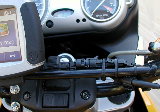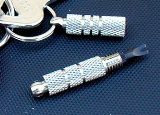GPS for Motorcycles: Garmin Zumo 550
In a way, I am somewhat conflicted about GPS for motorcycles. I mean, the whole idea is adventure, getting lost, getting away from it all, seeing what is over the next hill or around the next curve, discovering out of the way places, that little cafe that turns into a culinary oasis in a desert of fast food. When the Zumo lit up, I wondered, would it all disappear? Would I be chasing satellites instead of dreams?
On the contrary. In the extreme, you can always turn off the GPS, get really good and lost, then turn it back on to find your way out. It does not ruin an adventure any more than using a map, but it does make it easier. It does not show you what is over the next hill or around the next curve, but it will show you if it is a dead end or connects to other roads. Finally, though it will list restaurants, there is nothing to prevent you from asking fellow travelers or local people to recommend a good place to eat.
When it comes to GPS, competition is keen and there are many choices. Garmin has been the leader of the industry and offers a unit made specifically to meet the needs of motorcyclists, the Zumo. The model I have is the Zumo 550. They retail for over a thousand dollars, but you can find them on the Internet for as little as $730. (This was written in 2007.)
The waterproof Zumo has external buttons that can be operated left-handed and a touch screen. Mounted in its motorcycle bracket, you can use wired headphones, a necessity for the stereo XM radio option (yes, you read that right). Most riders take advantage of the wireless Bluetooth technology and mate their Zumo to their Bluetooth cell phone and Bluetooth headset or earpiece. Typically, riders mount the Zumo on their handlebars over the speedometer. You won't need the speedometer anymore. The Zumo constantly calculates and displays your speed. You will not need your clock, either. Satellite time, no extra charge.
It helps you find the road less traveled
The Zumo 550 offers three ways to look at a map. The default mode is what Garmin calls 3D, but not really. It is a perspective drawing that resembles what you will see looking down the road. I prefer the tracking mode. The map on the screen is oriented to the direction of travel, as you would a paper map. It has a scale which the 3D mode does not. The scale changes automatically as you speed up or slow down. You can override the scale by zooming in or out on the touch screen or with the left-hand buttons. The third mode is with north up.
The Zumo has the maps and the business telephone directories for North America. I still can't believe they got all that stuff in there, and the programs to run it, receive satellites and work the touch screen. You can search for and locate services anywhere, view a list of companies with directions and distances, select one, call it on your cell phone by touching the screen on the Zumo and calculate the route. Road block? No problem. The Zumo can plot a detour. But wait, there's more.
It can also store and display pictures or be used like an MP3 player to play music while you ride. At extra cost, in addition to XM radio, you can subscribe to traffic reports, tourist information and consumer information services. You can also buy nautical maps and use the Zumo on your boat. I have not used any of these.
There are some Zumo Bluetooth compatibility issues when using some Motorola cell phones with some Motorola headsets. The cell phones and headsets can be mated, but the Zumo is not able to differentiate between them. It is better to use a different manufacturer for one or the other.
Jill keeps it professional
Once you get all the electronics fired up, you can see your route and receive audio instructions. Wind noise can make the instructions impossible to understand. A good, quiet helmet and windshield is important to clearly hear the voice navigation instructions.
Of course, a rider does not have to have voice instructions. A rider could glance down at the screen and observe the map or read instructions, but the voice instructions are so very helpful in heavy traffic in a strange city. They allow you to keep your eyes on the road and concentrate on riding. It is very reassuring to hear Jill say, "In 400 feet, turn right onto Oak Street... Turn right onto Oak Street... Proceed north on Oak Street 3.2 miles to Highway 47 and turn left... " Thank you, Jill.

|
| MSD WeatherTight Connector allows ZUMO mounting bracket to be easily removed. |
The power cord for the Zumo is connected to the motorcycle mounting bracket. Most people wire the other end of the power cord directly to their battery. Keeping the unit powered up makes it easy to use during stops and eliminates having to reboot, enter your password and recalculate the route. Kickstand down is the best time for fiddling with Zumo addresses, routes, making phone calls and whatnot.
If you leave the bike unattended, pop the Zumo out of its bracket and take it with you or lock it out of sight in a hard case. If you simply hide it in a soft tank bag, tail pack or saddlebag, a thief might observe the mounting bracket and decide to hunt through your soft luggage for the Zumo. On my BMW F650GS, I wired a connector to the handlebars so I could easily remove the Zumo with the mounting bracket.

|
| Zumo Security Screw |
There is a security screw that uses a special tool, but it is still too easy for some miscreant to walk off with the Zumo and the bracket which is only held on by a wing nut. The security screw is mostly to prevent the Zumo from falling out of the mounting bracket on a rough road. By the way, keep the security screw screwed down tight even when the Zumo is not in the mounting bracket so it won't back itself out and fly away like mine did. One more item. In my opinion, the key ring hole for the security screw is in the wrong end of the tool. I drilled a hole in the other end on mine so the tool would be easier to use.
The Zumo will run on its internal battery for about three hours. You can carry it into a restaurant and plot the next leg of your journey while you wait for that hamburger. That's the time to return phone calls. Not while riding.
To be honest, I quit using the ear buds and blue tooth and just referred to the screen for the most part. When a phone call came in, a splash screen came up on the display and showed from whom the call was coming. Depending on the importance of the call, I would pull over when it was convenient for me to return it. One frustrating thing it took me a while to sort out was that if I was within 30 feet of the motorcycle, my cell phone would dial but I could not hear or talk to people. You have to move farther away or disconnect the power to the Zumo to use the phone.
To keep from having to look down and take my eyes off the road, I added an 8-inch extension from RAM to raise the display to about the same level as a rear view mirror. In my opinion, it's very risky to be making calls, studying the display and fooling with it while riding. Pull over and stop if it is going to take more than a glance.
The Zumo includes a mounting bracket for automobiles that makes the Zumo every bit as useful as any other automobile GPS unit around. The power cord plugs into your cigar lighter. No need for headphones in the car. The automobile mounting bracket has a speaker built into it and you can use it to make hands-free cell phone calls while you are driving.
Stick the Zumo car bracket to the windshield with the built in suction cup. I like to stick the suction cup on the driver side window near the outside rearview mirror. To locate the Zumo elsewhere, Garmin provides a shiny disc with double-sided tape on one side. The suction cup sticks securely to the slick side of the disc. Stick the 3M side of the disc onto a convenient surface, the underside of the dash above the instrument display for example. Again, over the speedometer is a good location. Be sure the disc is where you want it. Once it sticks, you will not be able to move it. There is also a beanbag mount and clip mounts available from companies like
GPS is the future. I like maps, but they are doomed to end up in museums as curiosities right next to sextants, compasses, chronographs and slide rules. Start saving your maps now: They will be collector's items.
